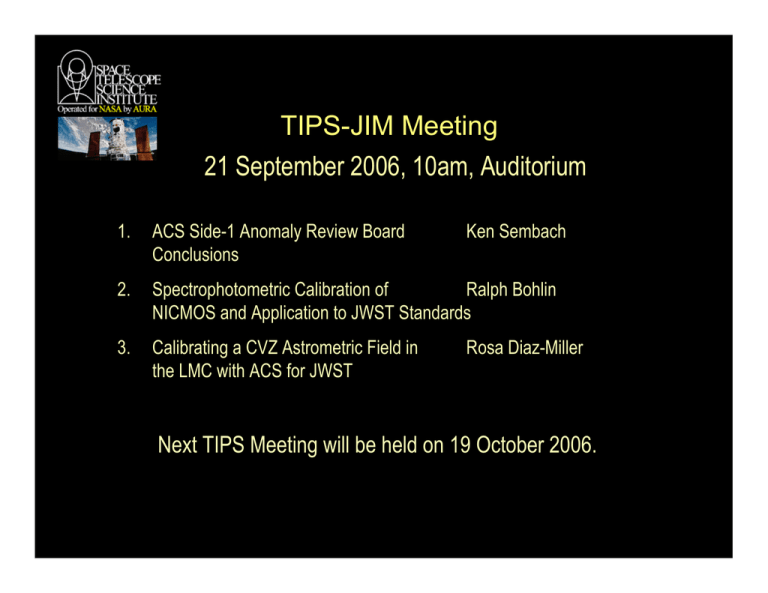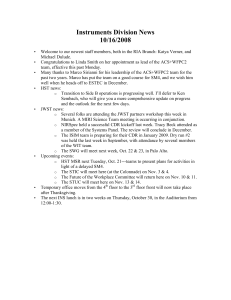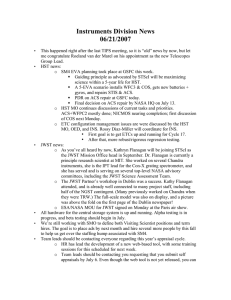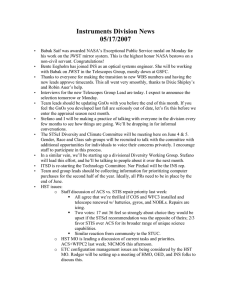TIPS-JIM Meeting 21 September 2006, 10am, Auditorium
advertisement

TIPS-JIM Meeting 21 September 2006, 10am, Auditorium 1. ACS Side-1 Anomaly Review Board Conclusions Ken Sembach 2. Spectrophotometric Calibration of Ralph Bohlin NICMOS and Application to JWST Standards 3. Calibrating a CVZ Astrometric Field in the LMC with ACS for JWST Rosa Diaz-Miller Next TIPS Meeting will be held on 19 October 2006. ACS Side-2 Performance Update STScI TIPS Meeting 20-July-2006 Ken Sembach 1 ACS Timeline Date (2006) Event June 19 ACS suspends at 17:15 UTC. Tiger Team formed. June 20 ACS Suspend Status Meetings start. Analysis of ACS data prior to suspension shows that it looks normal. SMOV preparations begin in case switch to Side-2 is necessary. June 21 ACS CEB Anomaly Review Board created. June 22 Observing timeline intercepted with SMS containing no ACS activities. Tiger Team passes off investigation to ARB. ACS transitioned to Operate mode on Side-1 as recommended by TT. June 23 ACS Team decides to recommend WFC temperature setpoint change. June 27 ARB recommends switch-over to Side-2. ARB endorses WFC temperature setpoint change. June 29 FRR for switch-over to Side-2 held - Switch-over approved. New FSW uploaded to ACS. June 30 Uplink and realtime switch to Side-2. CCD electronics boards powered. ACS safed for SMS intercept on July 2. 2 ACS Timeline (continued) Date (2006) Event July 2 Intercept of SMS with ACS activities. July 3 Successful checkout of ACS memory / dumps. July 4 WFC temperature setpoint lowered from -77 C to -81 C. Successful resumption of CCD calibration and science observations. July 7 ARB lifts moratorium on SBC observations. ARB considers risks/benefits of ACS Side-1 testing. July 11 ARB votes that risks to ACS assets outweigh benefits of Side-1 testing. July 12 Press release for first Side-2 science observation released. July 13 HST Project concurs that Side-1 tests should not be done at this time. July 16 SMS contains SBC SMOV activities. July-August Analysis of SMOV / science data in progress. 3 ACS Suspends • What was observed • All ones were read back from WFC and HRC CCD Electronics Box (CEB) A/D telemetry FIFOs • Status buffer messages : +15V and +5V supply voltages at high limits • 36 CEB limit-checked parameters were found to be out-of-limits • ACS current decreased 1.2-1.8 amps (no current spike in ACS) • Anomaly lasted about 7 seconds before ACS suspended • Ruled out • • • • WFC and HRC CEB interface optocouplers in common package WFC and HRC CEB FIFO read control CEB A/D converters Space weather-induced damage (excessive radiation) 4 CEB Power Switching All relays independent and switched by individual RIU commands LVPS1 ASPC1 (video) MEB2 ASPC2 (video) Clock1 (CCD control) MEB1 LVPS2 Clock2 (CCD control) Timing (main control) CEB All boards are needed for operation of the entire detector. Single fault affects at most half the science data. One CEB each for WFC and HRC Simplified – multiple diode busses in hardware Legend: 5V only 5 Anomaly Review Board Investigated Possible Failures Case # Failure Mode Anomaly match based on ETU testing Implicates Expected Telemetry +5V +15V -15V +35V +5V +15V -15V +35V 1 All Nominal No Problem intermittent or +15V open beyond TLM sample point 2 +15V open (external) YES LVPS #3 Board +5V 0V -15V 0V 3 +15V open (internal) YES MFL2815D +5V 0V -18V to -20V 0V 4 or 5 6 7 8 or 9 -15V open (external or internal) +15V shorted (internal or external) -15V shorted (internal or external) No MFL2815D or LVPS #3 +5V +15V 0V +35V YES MFL2815D or LVPS #3 or MEB Backplane or Harness to CEBs +5V 0V -6V to -8V 0V No MFL2815D or LVPS #3 or MEB Backplane or Harness to CEBs +5V +8V to +11V 0V +30V to +35V MFL2815D inhibited or internally destroyed No (additional testing in progress) MFL2815D +5V 0V 0V 0V Fault within MFL2815D Fault on LVPS #3 Board, not in MFL2815D Fault mode matches on orbit anomaly signature 6 ACS Resumes Exploration of the Universe 7 ACS Side-2 Orbital Verification Programs Program Analysis 10735 Cox SBC MAMA Recovery 4 (I) 10737 Mack / Gilliland CCD Stability Monitor 5 (E) 10738 Program Name Mack /Bohlin Earth Flats 10752 Sahu / Lallo 11005 Sirianni / Lucas 11006 Cox 11007 Welty 11008 Sirianni 11009 Welty Orbits 2 (I) Cycle 14 Focus Monitor 1 (E) Functional Test - MEB2 Switch 35 (I) SBC Filter Wheel Checkout 7 (I) ACS Side 2 Dump Test and Verification of ACS Memory Load 1 (I) ACS CCDs Side-2 Temp Setpoint 4 (I) ACS Science Data Buffer Check/ Self-Tests for CS Buffer RAM and MIE RAM 8 (I) 8 ACS WFC Temperature Setpoint Change • HRC TEC setpoint maintained at -80 C • WFC TEC setpoint lowered from -77 C to -81 C after Side-2 switch • Lower WFC setpoint should improve science • 2005 Aft Shroud Cooling System study • Fewer hot pixels (and fewer anneals needed) • Shorter charge transfer tails • Gain in sensitivity for deep exposures is ~ 0.1 magnitudes (or equivalently, about 20% in observing time) • Lowering temperature now consolidates recalibration activities for Side-2 switch and temperature change • Change would likely have been needed within the next 12-24 months 9 Dark Current / Hot Pixels WFC1 Side-2 (-81 C) Side-1 (-77 C) WFC2 Side-2 (-81 C) Side-1 (-77 C) Note: The white histogram is wider because only 4 images were used instead of 40. In both cases the tail of the histogram is for 1 single day, the first day after the anneals of July 14 (white) and June 15 (yellow). WFC1 WFC2 Dark Current: (e/pix/hr) Side-2 (-81 C) Side-1 (-77 C) 10.2 18.4 8.6 15.7 Ratio (-81 C / -77 C) 0.55 0.55 10 WFC Hot Pixel Contamination (%) Threshold (e-/pix/sec) Side1 (-77 C) Side2 (-81 C) (-81C /-77C) >0.01 22.2 9.0 0.41 >0.04 3.8 1.3 0.34 >0.08 1.6 0.6 0.37 >0.10 1.1 0.5 0.45 Ratio of Hot Pixels (-77 C / -81 C) Ratio Side-1 (-77 C) Side-2 (-81 C) Note: 100x80 pix region, first day after annealing (only pixels brighter than 0.08 are shown) 11 Gain Ratio • WFC: Gain=1 and Gain=2 (default) • Side-2 Ratio • Same as on Side-1 to 1 part in 104 (47 Tuc data) • Quad-quad gains are consistent to 1 part in 103 (internal flats) 12 WFC Bias Jumps A Typical case A B B 1 DN C C D D Image stretched to show bias jumps. 1 DN 13 WFC Bias Jumps A Worst case A B B 1 DN C C D D Image stretched to show bias jumps. 1 DN 14 WFC Bias Jumps • WFC • Side-1 (Gain=2, default) • Jump detected in 1/40 images • Jump detected only on Amplifier B • Side-2 (Gain=2, default) • Jump detected in 7/35 images • Jump detected on 2 or 4 amplifiers simultaneously • Side-2 (Gain=1) • Jump detected in 5/35 images • Jump detected only on 1 amplifier at a time, mostly Amp B • HRC • No bias jumps observed on Side-1 or Side-2 15 Sensitivity • Small sensitivity decrease (expected) seen after lowering WFC setpoint • Sensitivity measured using stellar photometry and internal flatfields Filter Gain Side-2 Change in QE F435W 2 F475W 2 -2.1% F606W 1,2 -1.2% F625W 2 -0.9% F775W 2 -1.1% F814W 1,2 -2.6% -1.1% -2.2% (Internal) -1.7% (Internal) A 4096x4096 composite WFC/F606W image of a portion of globular cluster 47 Tuc obtained on Side-2 (4 x 339 sec). 16 Point Spread Function •Astrometric and photometric analysis of WFC Side-2 47 Tuc data (J. Anderson) • Temporal change noted was well within normal orbit-orbit and epoch-epoch ranges • No evidence for additional underlying spatial dependence of PSF Constant Library Library + Perturbation Empirical library PSF for WFC/F606W On average, 22.4% of light falls in central pixel (+15%, -12%) -1 +3 -1.0 -5 +1 -0.5 +6 +2 +0.3 +7 +3 +0.5 % Residual Photometry supported to 0.005 mag Astrometry supported to 0.01 pix in both x and y Same as on Side-1 17 Mechanisms Affected by Side-2 Switch • Fold mirror / cal door / coronagraphic spot • Resolvers and electronics • Positions are within usual ranges seen for Side-1 motions. • Filter wheels • Resolvers and electronics • Filter Wheel #1: positions are the same as on Side-1 • Filter Wheel #2: currently a small offset w.r.t. Side-1 (investigating) • Shutter • LEDs, photodiodes, and electronics • No test performed yet • Post-flash illumination • LED • No test performed yet (low priority) 18 Coronagraphic Spot Position Side-2 Motion on Side-2 is well within historical Side-1 envelope of positions. 19 NICMOS SPECTROPHOTOMETRY R. Bohlin 06Sep21 1. Review non-linearity 2. Primary, secondary standard stars 3. JWST standard star program REFERENCES Grism Sensitivities and Apparent Non-Linearity, R. C. Bohlin, D. Lindler, & A. Riess 2005, Instrument Science Report, NICMOS 2005-002, (Baltimore:STScI) NICMOS Count Rate Dependent Non-Linearity in G096 and G141, Bohlin, R. C., Riess, A., & de Jong, R., 2006, Instrument Science Report, NICMOS 2006-002, (Baltimore:STScI) *ISRs @ http://www.stsci.edu/hst/nicmos/documents/isrs Bohlin, R. C. 2007, in The Future of Photometric, Spectrophotometric, and Polarimetric Standardization, ASP Conf. Series, Vol. xxx, ed. C. Sterken, "HST Stellar Standards with 1\% Accuracy in Absolute Flux", also Astro-Ph 0608715 Calibrating a CVZ Astrometric Field in the LMC with ACS for JWST Rosa I. Diaz-Miller Space Telescope Science Institute September 21st, 2006 TIPS Meeting Astrometric Field in the LMC with ACS for JWST ◆ • • • • • Collaborators: Jay Anderson (Rice University) Ralph Bohlin (STScI) Stefano Casertano (STScI) Jerry Kriss (STScI) Matt McMaster (STScI) Sep 21st, 2006 • • • • Massimo Stiavelli (STScI) Vera Platais (STScI) James Rhoads (UA) Jeff Valanti (STScI) Rosa Diaz-Miller Astrometric Field in the LMC with ACS for JWST ◆ ◆ ◆ Rationale for Cross Calibration of JWST Strategy for securing an astrometric field Preliminary results Sep 21st, 2006 Rosa Diaz-Miller Rationale for Cross Calibration ◆ HST astrometric observations are essential for calibrating JWST field distortion. ➥ Meet JWST calibration requirements Field distortion correction within any instrument and guide star shall not exceed 0.005 arcsec RMS ➥ This will enable the precise target positioning required for multi-object spectroscopy with NIRSpec. ➞ MSA: (750 x 350) shutters, each (200 x 450) mas2 ➥ ➥ Enable higher quality science early in mission. ◆ JWST self calibration? o ➥ JWST roll angles at one time +/- 5 ➥ JWST will need more than 60 days to attempt good self calibration of an astrometric field. ➥ Changes in stability of JWST’s mirror might have smaller time scales. Sep 21st, 2006 Rosa Diaz-Miller Astrometric Field in the LMC with ACS for JWST ◆ Added Advantages of HST-JWST cross calibration: ➥ Save JWST observing time ➥ External check on JWST astrometric solutions ➥ HST/ACS field with astrometric precision better than can likely be obtained from JWST alone. ◆ How well can ACS do? ➥ Arbitrary ACS-WFC fields can achieve 5 mas accuracy. ➥ Errors less than 2 mas are possible with proper distortion correction using multiple roll angles. Current distortion correction => 0.01 pixels and 0.01 mag accuracies for ACS/WFC (Anderson & King 2000, 2003,2006) Sep 21st, 2006 Rosa Diaz-Miller Astrometric Field in the LMC with ACS for JWST ◆ Astrometric-calibration field for JWST: ➥ High stellar density ➥ Most stars usable ➥ Stellar density variation < 2 ➥ Separation ~10 FWHM ➥ S/N ~ 100 at V=24 ➥ Small proper motions ➥ Field in the JWST CVZ Sep 21st, 2006 Rosa Diaz-Miller Astrometric Field in the LMC with ACS for JWST ◆ LMC is ideal. About 10 stars per 3.75x3.75 arcsec2 C. Smith, S. Points, the MCELS Team and NOAO/AURA/NSF Sep 21st, 2006 Rosa Diaz-Miller Astrometric Field in the LMC with ACS for JWST ◆ Astrometric Calibration Strategy to get errors < 2 mas ◆ Multiple dithered observations of the same field and different roll angles ➥ ACS-WFC filter F606W ➥ Mosaic of images to cover a 5.4x5.4 arcmin2 region. ➥ 5 fields, 60” apart ➥ 6 points dither pattern per field with steps of ~3-10 arcsec ➥ Large dynamic range ➥ Two roll angles separated by 75o ➥ 30” dithers Sep 21st, 2006 Rosa Diaz-Miller Astrometric Field in the LMC with ACS for JWST ◆ Correcting for distortion ➥ Use PSF library to determine position of each star (Anderson & King 2005, PASP, 115, 113; ACS ISR 2006-01) ➥ Measure all the stars in each image. ➥ Solve for the distortion coefficients fitting the residuals with fourth-order polynomials ➥ Cross identify stars in the various images. Anderson, J. 2005, HST Calibration Workshop Sep 21st, 2006 Rosa Diaz-Miller Astrometric Field in the LMC with ACS for JWST ◆ First orientation: 30 exposures ◆ About 100,000 bright enough stars in the field. (J. Anderson) Composite image Sep 21st, 2006 Close up Rosa Diaz-Miller Astrometric Field in the LMC with ACS for JWST Identified stars in each field (field P1 in red, P2 in blue, P3 green, P5 magenta) Close-up Sep 21st, 2006 Rosa Diaz-Miller Astrometric Field in the LMC with ACS for JWST ◆RMS residuals for first orientation fields. ◆ PSF blurrier than library ( ~10% less flux in the core.) ◆ Current accuracies ~0.03-0.02 pixels Sep 21st, 2006 Rosa Diaz-Miller Astrometric Field in the LMC with ACS for JWST RMS residuals along x axis for field P1 Sep 21st, 2006 Rosa Diaz-Miller Astrometric Field in the LMC with ACS for JWST ◆ RMS residual along Y axis for field P1 Sep 21st, 2006 Rosa Diaz-Miller Astrometric Field in the LMC with ACS for JWST ◆ RMS residuals are derived from 6 dither pointings with the constrain that a star should be at least in 5 of the 6 pointings ➥ Since we have large dithers => in this analysis we are missing some stars. ➥ Need to change this constrain ➥ Need to add the short exposure ◆ After all geometric distortions have been removed from the 5 fields, we are still left with a distortion that has scales of about 1000 pixels. We need to remove this distortion. Sep 21st, 2006 Rosa Diaz-Miller Astrometric Field in the LMC with ACS for JWST AVG= 30 pointings Sep 21st, 2006 Rosa Diaz-Miller Astrometric Field in the LMC with ACS for JWST AVG= 30 pointings Sep 21st, 2006 Rosa Diaz-Miller Astrometric Field in the LMC with ACS for JWST RMS residuals for master frame (average of 30 pointings) Sep 21st, 2006 Rosa Diaz-Miller Astrometric Field in the LMC with ACS for JWST RMS residuals for master frame (average of 30 pointings Sep 21st, 2006 Rosa Diaz-Miller Astrometric Field in the LMC with ACS for JWST ◆ Second orientation: 12 pointings ➥ Stars well fit by the empirical PSF library ➥ Internal consistency with which we are measuring positions and fluxes is better than 0.01 pixel and 0.01 mag ➥ We need to compare with first orientation Sep 21st, 2006 Rosa Diaz-Miller Astrometric Field in the LMC with ACS for JWST ◆ Summary ➥ First orientation: 30 pointings ➞ Current accuracies ~0.03-0.01pixels ➞ Re-derive PSF library? ➞ Add short exposures. ➞ Find extra correction to the distortion. ➥ Second orientation: 12 pointings ➞ Stars very well fit by my empirical library PSF ➞ Compare with first orientation ➥Expect to get accuracies to 1mas (0.5 mas) ➞ Need to remove extra distortion first Sep 21st, 2006 Rosa Diaz-Miller




